Latest findings
Gaining access to nutrients is the primary benefit from chemotaxis
Matilla et al. (2023) Curr. Opin. Microbiol. 75: 102358.
Our knowledge on chemoattractants, or compounds that induce a directed, flagellum-mediated movement, is growing rapidly and new chemoattractants are discovered regularly. We discuss here several observations that strongly suggest that the access to nutrients is the primary force that has driven the evolution of the chemotactic system. Among these observations are the notion that most chemoeffectors are of metabolic and that many different chemoreceptor sensor domains have evolved that bind metabolic value compounds, as illustrated in the Figure below by the different sensor domains for Krebs cycle intermediates. Furthermore, several studies report a growth-rate dependent modulation of chemotaxis gene expression and several broad ligand range chemoreceptors bind preferentially metabolic value compounds. Exchange of metabolic value compounds between bacteria and phytoplankton was shown to be enhanced by chemotaxis that in turn plays a major role in shaping marine ecosystems.
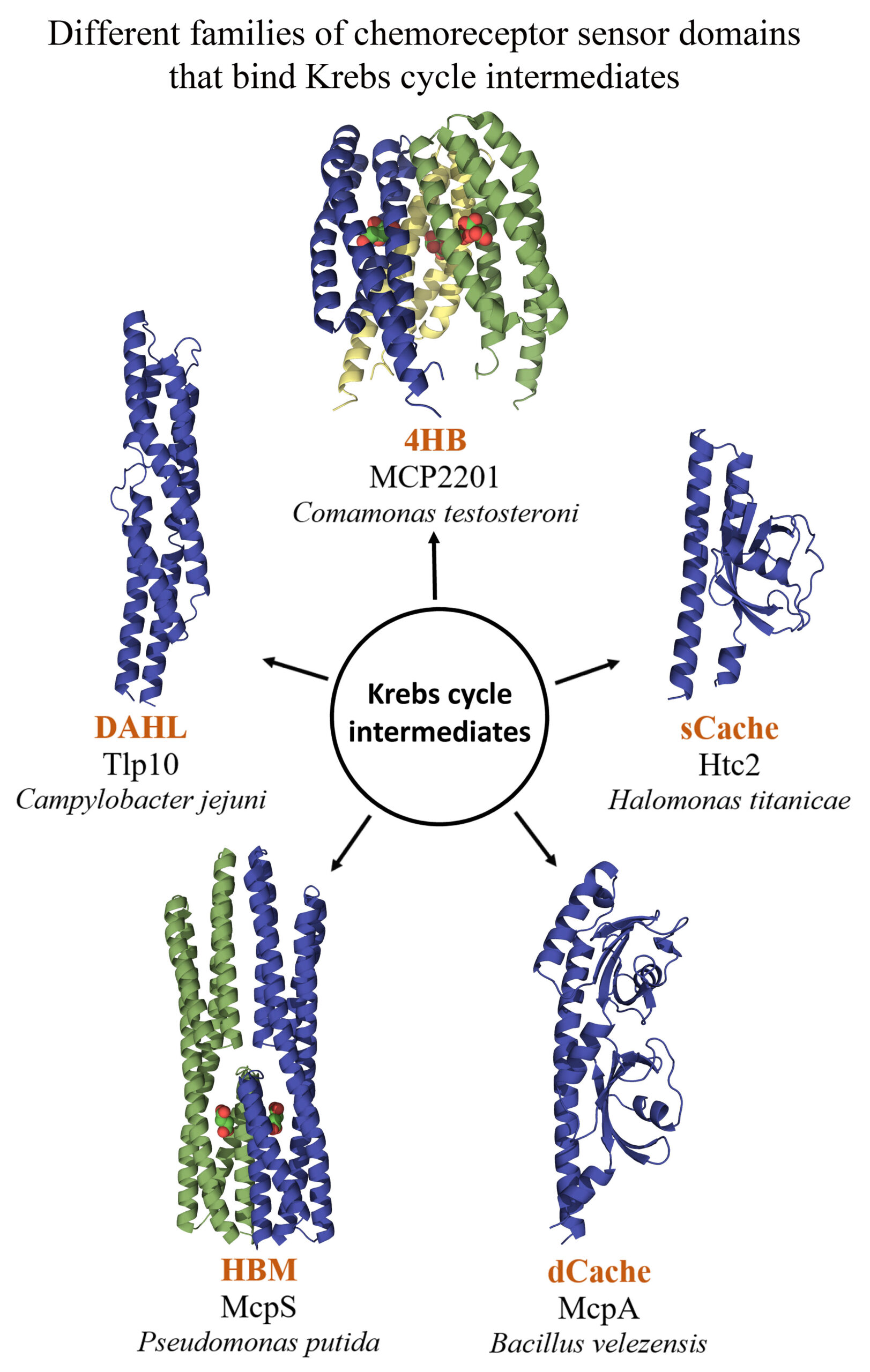
A bacterial chemoreceptor for the neurotransmitter acetylcholine
Matilla et al. (2022) mBio e0345821
There is doubt that that the chemosensory capacity of a bacterium is a reflection of its lifestyle. However, a more detailed understanding on the chemoeffectors perceived by bacteria with a given lifestyle is still missing. In this publication we show that the human pathogen Pseudomonas aeruginosa shows strong chemoattraction towards acetylcholine, a central neurotransmitter in human. Acetylcholine was found to bind to the dCache type sensor domain of the PctD chemoreceptor. To determine the molecular determinants of acetylcholine recognition we report the high-resolution structures of the PctD sensor domain in complex with acetylcholine and that of the homologous PacA chemoreceptor that is unable to recognize acetylcholine. Interestingly, in previous studies, Reyes-Darias et al. (2015) and Corral-Lugo et al. (2018) we have identified two other P. aeruginosa chemoreceptors, PctC and TlpQ, that recognize the neurotransmitters GABA and histamine, suggesting a particular relevance of neurotransmitter chemotaxis in P. aeruginosa. This study expands the range of biologically relevant signal molecules that are perceived as chemoattractants by bacteria.

A catalogue of signal molecules that interact with sensor kinases, chemoreceptors and transcriptional regulators
Matilla et al. (2021) FEMS Microbiol Rev. 10.1093/femsre/fuab043.
We have compiled a catalogue of 1750 interactions of signal molecules with the three major super-families of bacterial signal transduction proteins, namely sensor kinases, chemoreceptors and transcriptional regulators. These proteins recognize signal molecules typically at their sensor or ligand-binding domain. Data were extracted manually from about 1200 articles and the protein data bank. This catalogue contains 811 proteins. Importantly, only data showing direct interactions were considered and indirect evidence such as in vivo gene expression in the presence of signal molecules were not included. Proteins were classified according to the Pfam family of their respective sensor domains into 127 groups. This work reveals the signal binding characteristics of a large part of bacterial sensor domains. Whereas some sensor domains showed significant promiscuity in signal recognition, other domains were found to possess a well-defined signal profile. The lacking knowledge of the signal molecules that active bacterial signal transduction systems is a major bottle neck in microbiology and this work will facilitate the identification of signals that bind to homologous but uncharacterized sensor proteins.
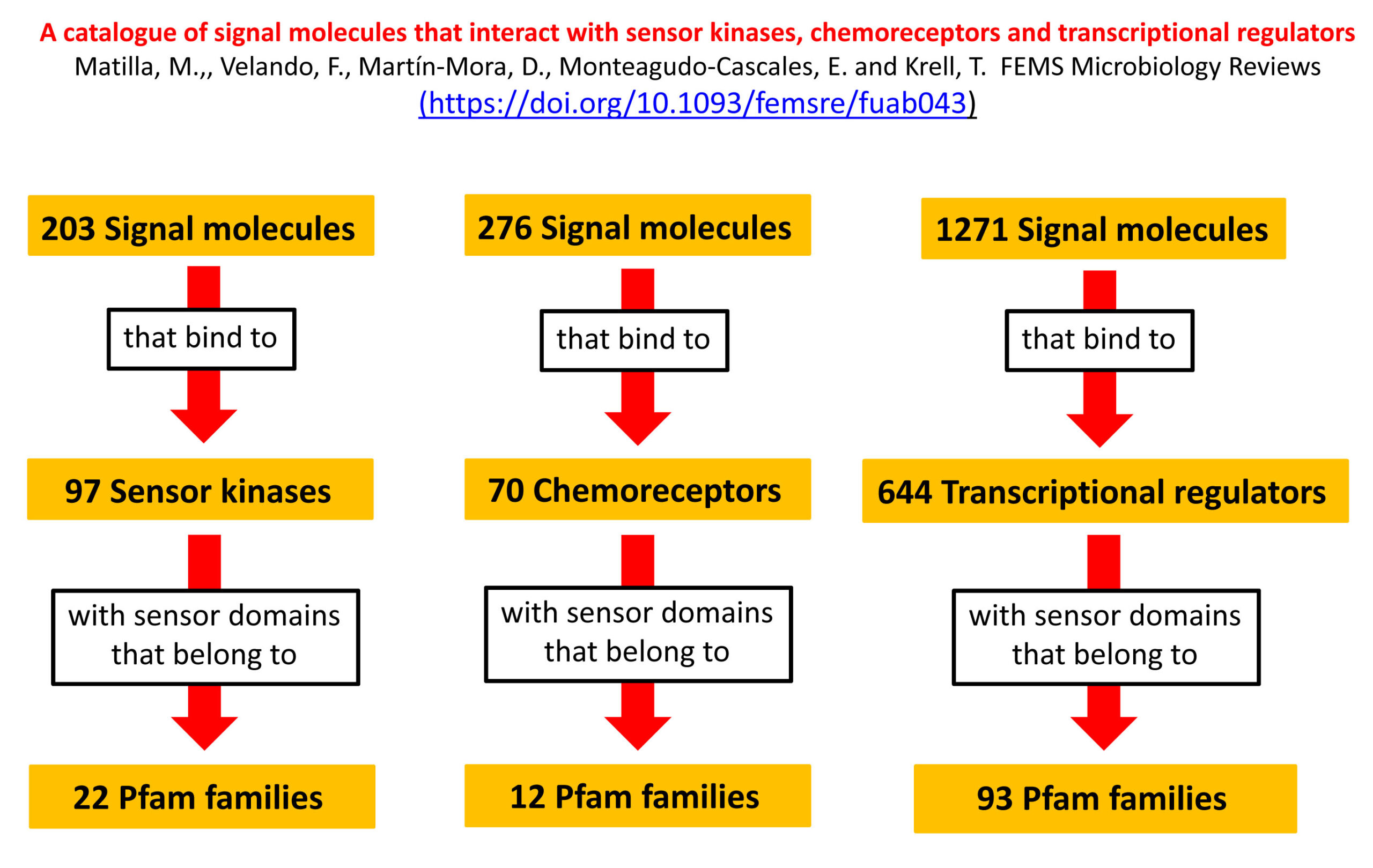
Review article on chemosensory pathways with different function
Matilla et al. (2021) Microbiol. Mol. Biol. Rev. 85(1):e00151-20
Pseudomonas aeruginosa has 26 chemoreceptors that stimulate in total four different chemosensory pathways. These pathways differ in function: The che pathway mediates chemotaxis, the wsp pathway modulates c-di-GMP levels, the chp pathway is associated with type IV pili based motility and cAMP levels, whereas the function of the che2 pathways is unknown. To some extent all pathways are involved in virulence. There is now a large body of information available on these pathways making P. aeruginosa a convenient model organism. We have reviewed these data and hope this is of help to the scientific community.

Understanding how new chemoreceptors evolve
Many bacteria possess a large number of chemoreceptors that each respond to different signal molecules and frequently genomes contain paralogous receptors that have arisen by gene duplication. We have studied chemoreceptor evolution using the three paralogous receptors PctA, PctB and PctC of Pseudomonas aeruginosa as examples. Whereas PctA is a broad range receptor that responds to most proteinogenic amino acids, PctB and PctC recognize preferentially L-Gln and GABA, respectively. In a stimulating collaboration with the laboratory of Igor Zhulin (Ohio State University) we show that pctA gene duplication in the common ancestor of the genus Pseudomonas led to pctC, whereas pctB originated through another, independent pctA duplication in the common ancestor of P. aeruginosa. The 3D structures of the ligand binding domains of these three receptors in complex with several ligands were solved in an excellent collaboration with the laboratory of Jose A. Gavira and reveal the structural basis for differential ligand recognition.
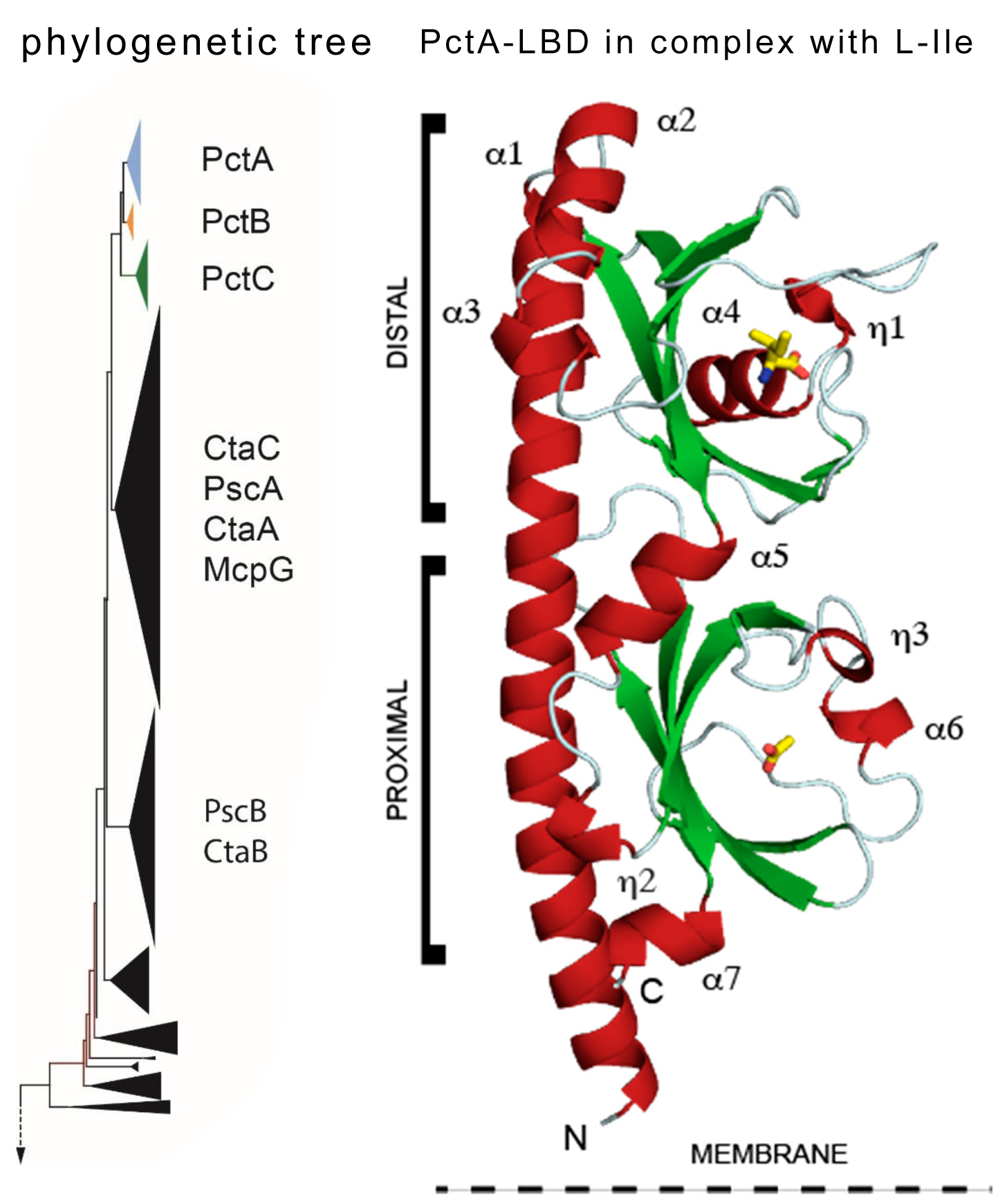
Bioinformatic analysis of chemoreceptors with a C-terminal pentapeptide for CheR and CheB binding
Ortega, A., Krell, T. (2020) Comput. Struct. Biotechnol. J. 18:1947-1955.
We have analysed the totality of currently available chemoreceptor sequences and have investigated the presence of C-terminal pentapeptides. The main conclusions are:
- Approximately 10 % of bacterial chemoreceptors contain such pentapeptides.
- Almost no pentapeptide containing chemoreceptors are found in archaea.
- Pentapeptide containing chemoreceptors are more abundant in GRAM – than GRAM + bacteria.
- Pentapeptides are present in cytosolic (7.5 %) as well as transmembrane (11.5 %) chemoreceptors.
- The abundance of chemoreceptors with C-terminal pentapeptides correlates negatively with the number of chemoreceptors per genome.
- The maximal number of pentapeptide containing receptors per genome is of 27.
- The abundance of pentapeptides differs largely in receptors with different ligand binding domains (LBD, figure below): almost 50 % of TarH domain containing chemoreceptors possess pentapeptides, whereas the families of GAF and PilJ domain containing receptors have almost no pentapeptides.
- Pentapeptides are always fused to the C-terminus of an MCP, regardless whether the last domain is an LBD or signaling domain.
- Bacteria that inhabit the human intestinal flora possess a high abundance of pentapeptide containing chemoreceptors.
- Pentapeptide containing chemoreceptors are found in 11 different phyla.
- Chemoreceptors with pentapeptides are highly abundant in the order Enterobacterales (36 %).
- The abundance of pentapeptide containing chemoreceptors in several orders that contain primarily bacteria with a free-living lifestyle is reduced such as 1 % for Pseudomonadales.
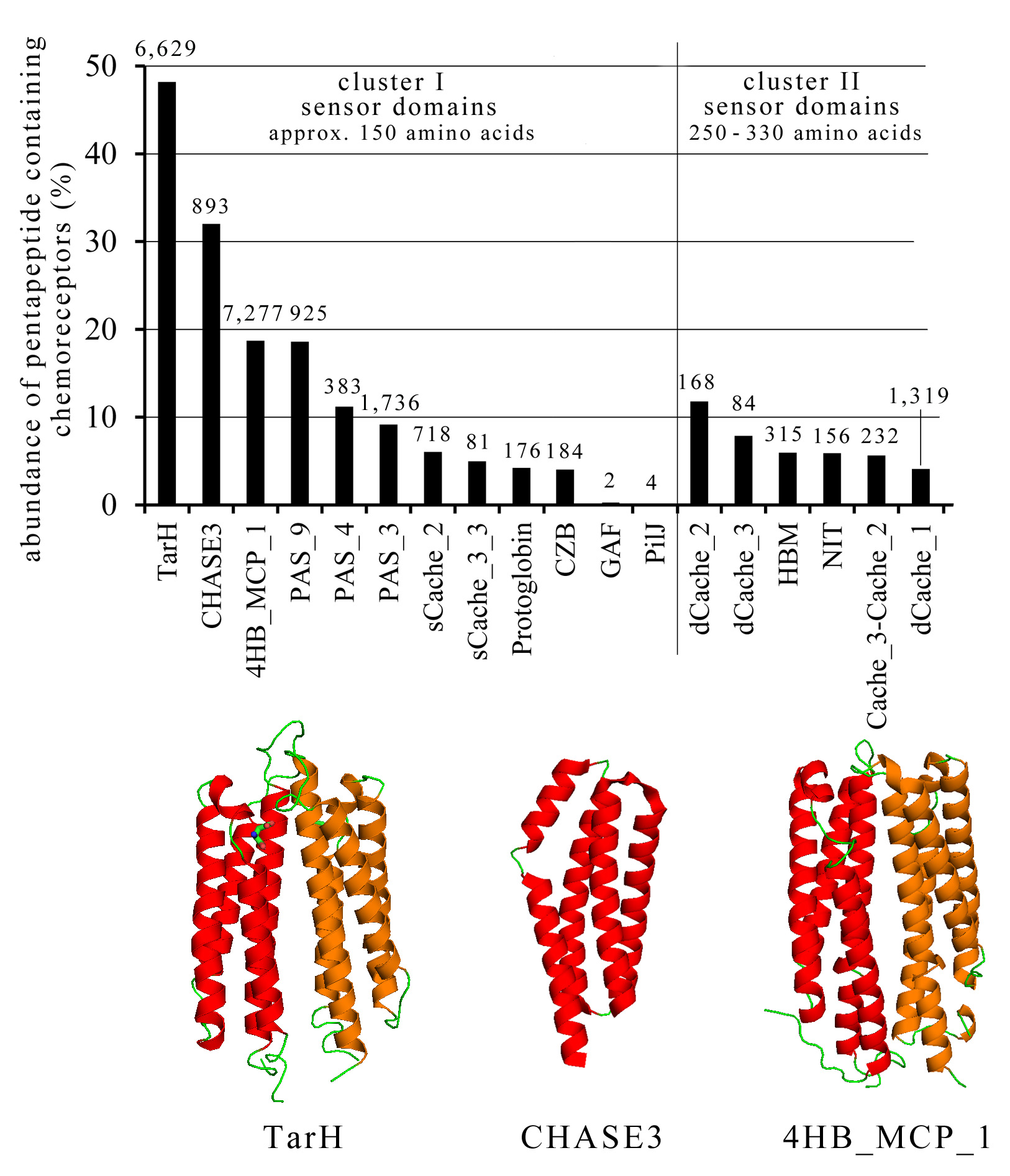
Identification of the molecular basis of nitrate chemotaxis
Nitrate is of central relevance in bacterial physiology and it is known for a long time that many bacteria are able to perform taxis towards nitrate. So far, data suggest that these movements are based on energy tactic mechanisms in which metabolic consequences of nitrate metabolism are monitored. In this article we report a mechanism for nitrate chemotaxis that is based on the specific recognition of this ligand by the periplasmatic PilJ-type sensor domain of the McpN chemoreceptor of Pseudomonas aeruginosa. Nitrate chemotaxis occurred only under nitrate limiting condition, an observation that is most likely due to the nitrate-mediated reduction of mcpN transcript levels. We report the 3D structure of the McpN sensor domain in complex with nitrate at a resolution of 1.3 Å in which one nitrate molecule was bound at the dimer interface. McpN homologues were identified in many bacteria and were particularly abundant in species that couple sulfur/sulfite oxidation with nitrate reduction. Nitrate chemotaxis is likely to be a widespread phenomenon with importance for the life cycle of ecologically diverse bacteria.
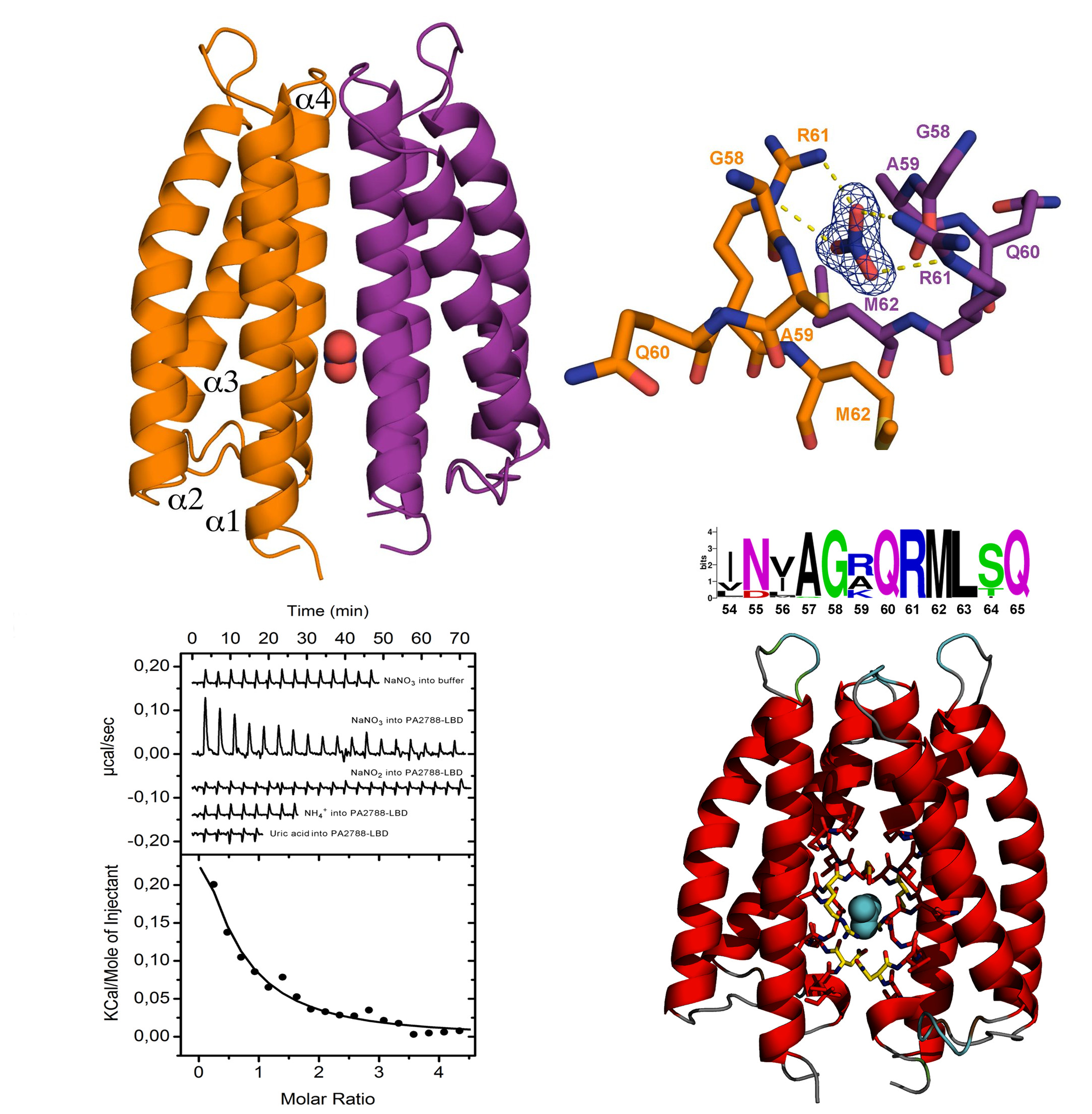
An auxin controls antibiotics production in bacteria
Antibiotics production is costly to the bacterial cell and therefore in many cases subject to strict regulation. However, there is limited knowledge on the environmental cues that control antibiotics production and their corresponding mechanisms. The transcriptional regulator AdmX of the plant-associated bacterium Serratia plymuthica A153 was shown to control the synthesis of the antibiotic andrimid. AdmX contains a ligand binding domain of which we speculated to bind environmental signals that modulate its activity. Using high throughput approaches and purified protein we screened some 1700 compounds for binding and identified the auxin indole-3-acetic acid (IAA) as ligand. Antibiosis assays showed that IAA reduces andrimid production in a dose-dependent manner leading to undetectable andrimid production at 400 µM. AdmX was shown to control the transcription of the genes encoding the biosynthetic andrimid cluster. IAA is produced by plants and bacteria, and our study shows that the synthesis of IAA by other plant-associated bacteria results in the inhibition of andrimid production, suggesting that IAA bacterial production corresponds to a mode of inter-species communication.
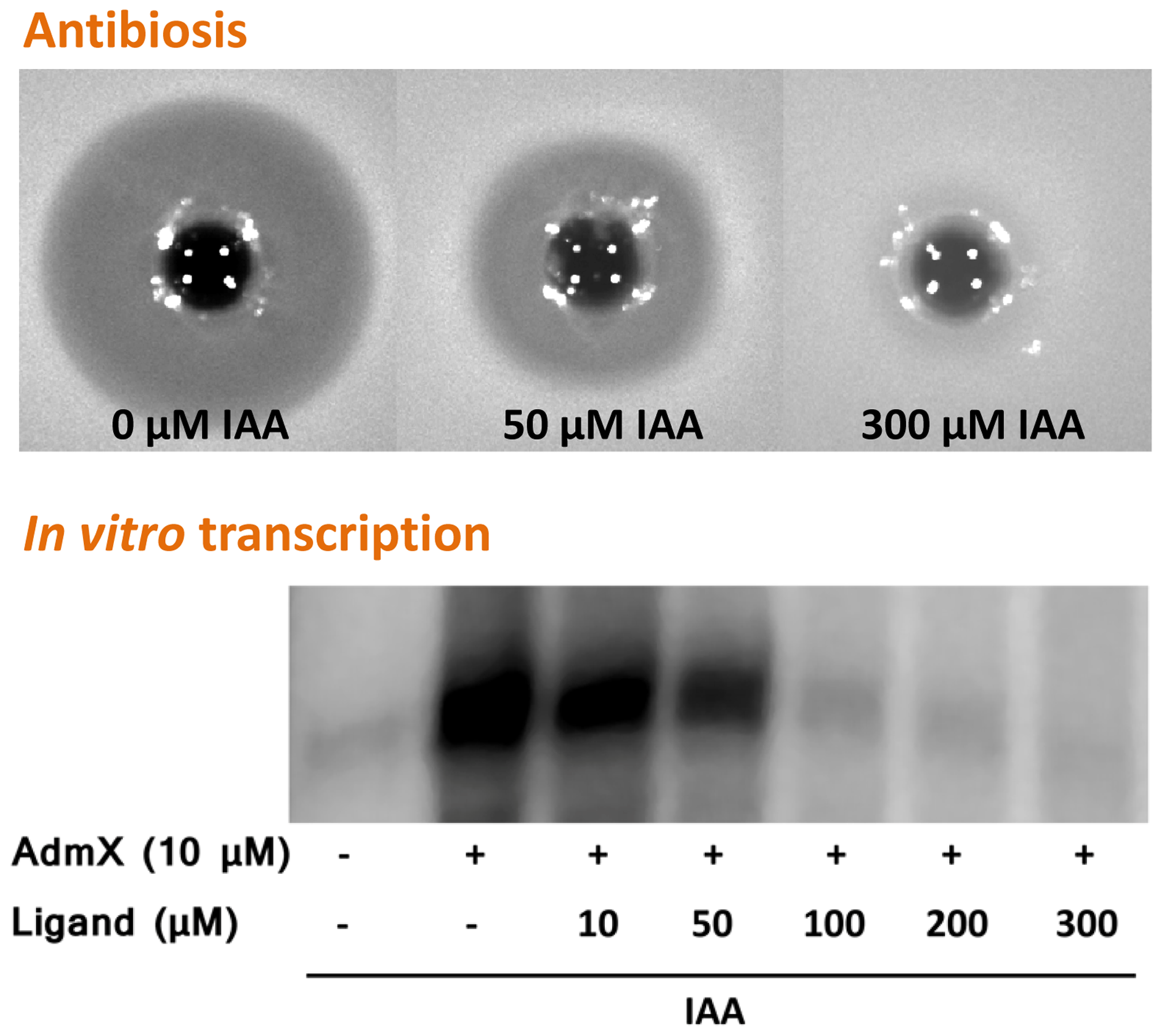
Bacterial chemotaxis to histamine
Histamine is a key signal molecule that coordinates the immune response. Previous studies have shown that the infection with the human pathogen Pseudomonas aeruginosa increases histamine secretion by neutrophils. In our article Corral-Lugo et al. (2018) mbio 9, e01894-18 we demonstrate that P. aeruginosa shows high-sensitivity chemotactic responses to histamine. These responses are primarily mediated by the TlpQ chemoreceptor that binds histamine with nanomolar affinity. The three-dimensional structure of the TlpQ ligand binding domain reveals that it is a dCACHE domain that contains bound histamine in its membrane distal module. Histamine chemotaxis is likely to play a role in bacterial virulence since it will induce bacterial migration to infection sites. This in turn alters the local bacterial quorum, causing a modulation of the expression of quorum sensing controlled virulence genes.
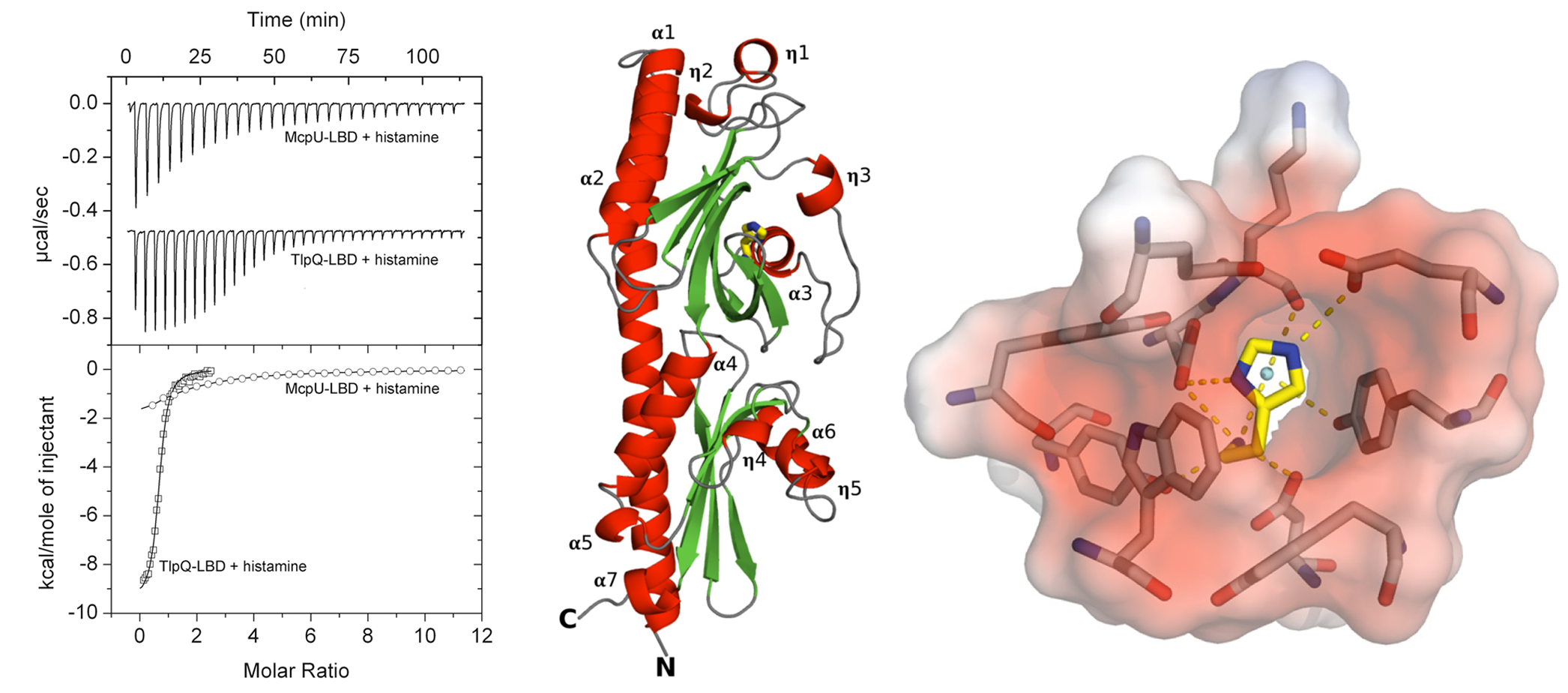
The McpB (Aer2) chemoreceptor is involved in Pseudomonas aeruginosa virulence
P. aeruginosa has 26 chemoreceptors that feed into four different chemosensory pathways. Only one chemoreceptor, McpB (Aer2), was predicted to feed into the F7 (che2) pathway. This pathway is of unknown function but likely to be involved in bacterial virulence. In collaboration with the laboratory of Maximino Manzanera from Granada University, we show that the deletion of the mcpB gene reduces bacterial virulence in a number of different animal models and mutant complementation restores wild-type like virulence (García-Fontana et al. (2019) Sci. Rep. 9:13166). These findings support the notion that McpB feeds into the F7 pathway and future studies are necessary to identify the pathway output.
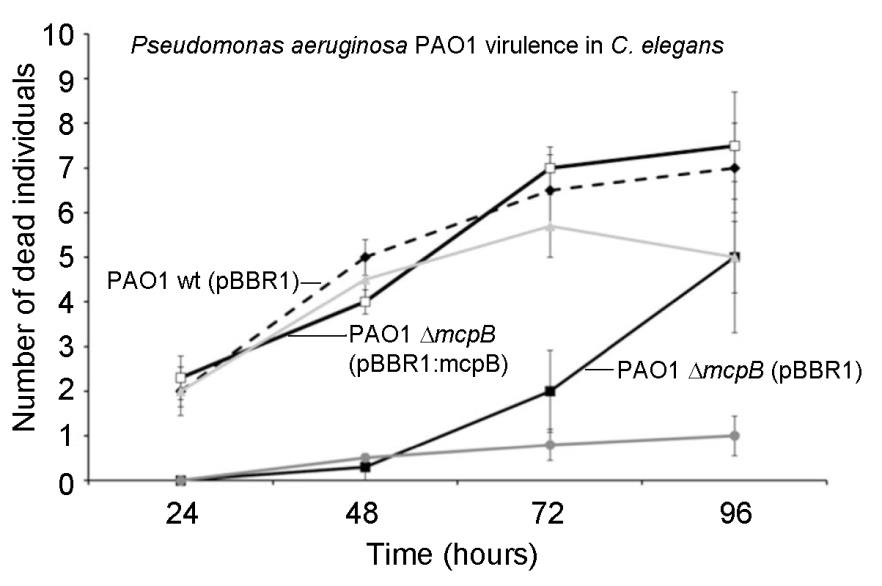
The plant compound Rosmarinic acid induces a broad quorum sensing response in Pseudomonas aeruginosa
We have shown previously that rosmarinic acid (RA) binds to the RhlR quorum sensing regulator, regulates the expression from several RhlR controlled promoters, which manifests itself in several quorum sensing (QS) related phenotypes (Corral-Lugo et al. (2016) Science Signaling 409:ra1).
In Fernández et al. (2018) Env. Microbiol. we have now assessed the global effect of RA on P. aeruginosa transcript levels using RNA-seq. RA induced the expression of 128 genes, amongst which many virulence factor genes. RA triggers a broad QS response because 88% of the induced genes are known to be controlled by QS, and because RA stimulated genes were found to be involved in all four QS signaling systems within P. aeruginosa. As shown in the Figure below there was a close overlap between RA induced genes and those induced by acylhomoserine lactone ligands.
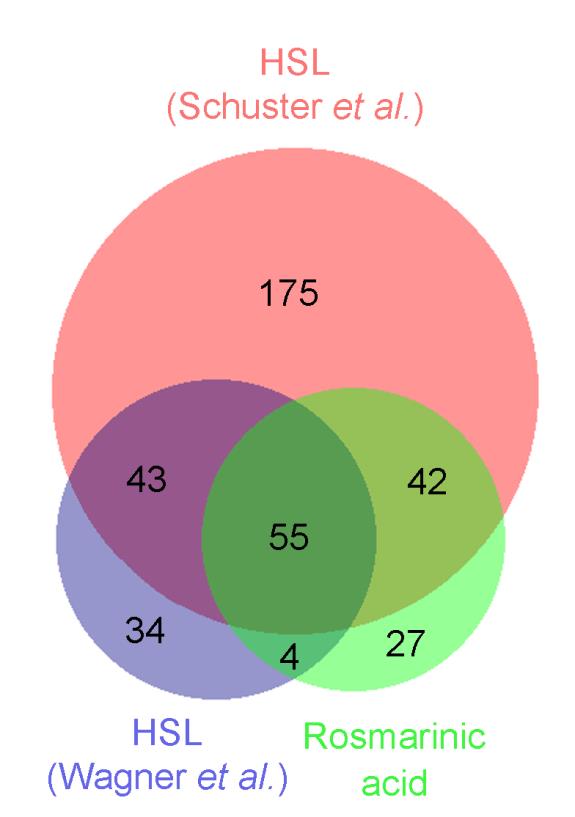
RNA-seq results were verified by promoter expression studies using lacZ fusions. As exemplified by the hcn and lasI promoters significant induction by RA and C4-HSL was observed in the wild type (not shown) and the rhlI/lasI double mutant (below). However, no induction was observed in the rhlI/lasI/rhlR triple mutant, which is consistent with the notion that regulatory effects observed are due to the RA-RhlR interaction.
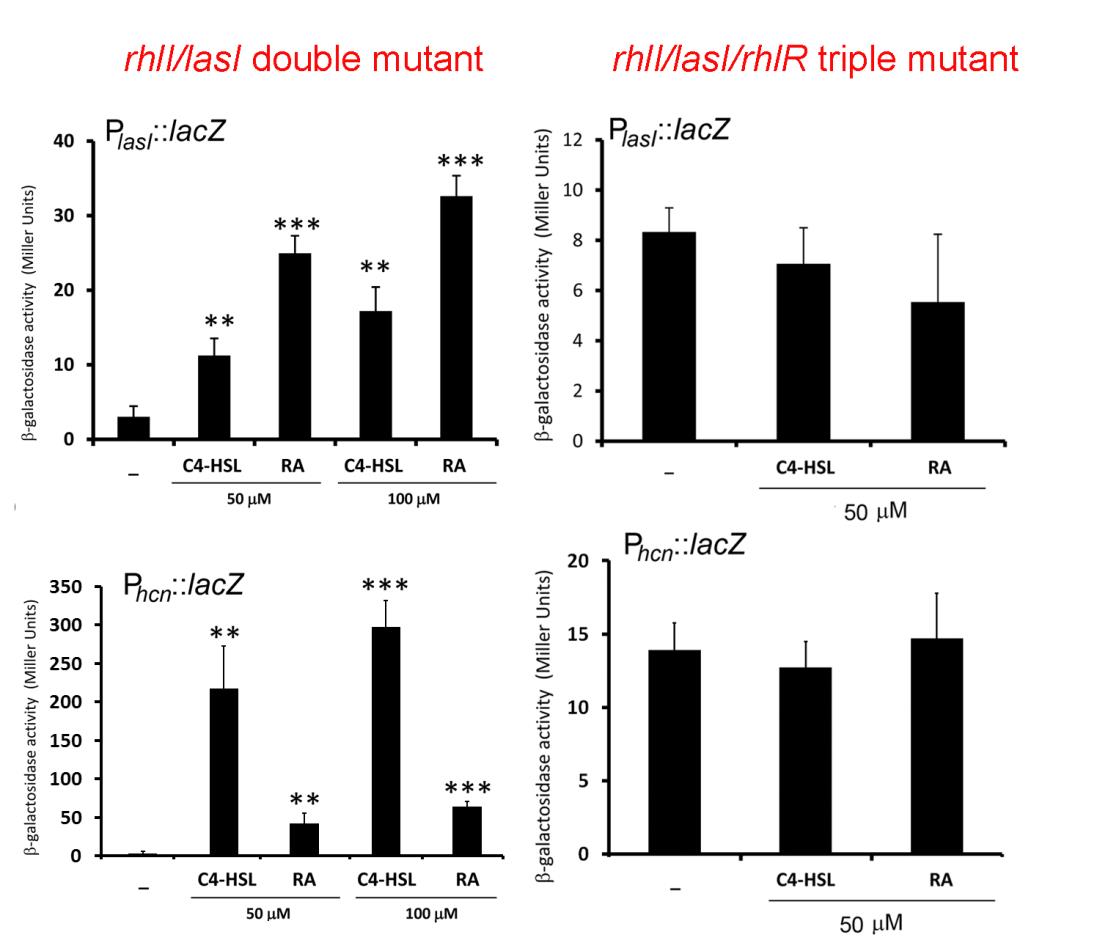
Three dimensional structure of the ligand binding domain of the Pseudomonas putida polyamine receptor
We have previously identified with McpU the first chemoreceptor that binds specifically different polyamines (Corral-Lugo et al. (2016) Env. Microbiol.). We now report the three dimensional structure of the McpU ligand binding domain in complex with putrescine, which has been solved by the Gavira laboratory. It is a dCACHE domain that contains bound putrescine in the membrane distal module.
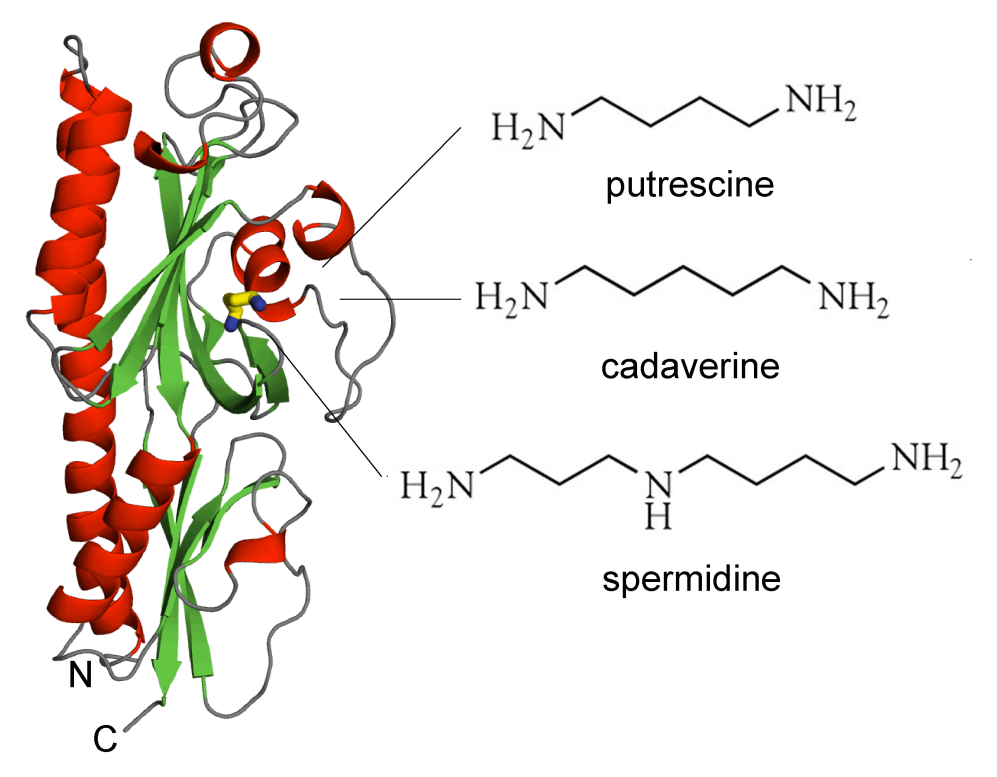
Well-defined density was observed for putrescine which allowed the precise placement of the ligand (below). Significant similarities were identified in the ligand binding mode of McpU and the Mlp37 chemoreceptor of Vibrio cholerae in complex with taurine. Both ligands possess a primary amino group that is recognized by the protein in a similar manner, namely involving an Asp/Tyr/Asp triad (below). Both ligand binding domains share only 15 % sequence identity, but this feature can potentially be used to identify sensor domains that recognize primary amines.
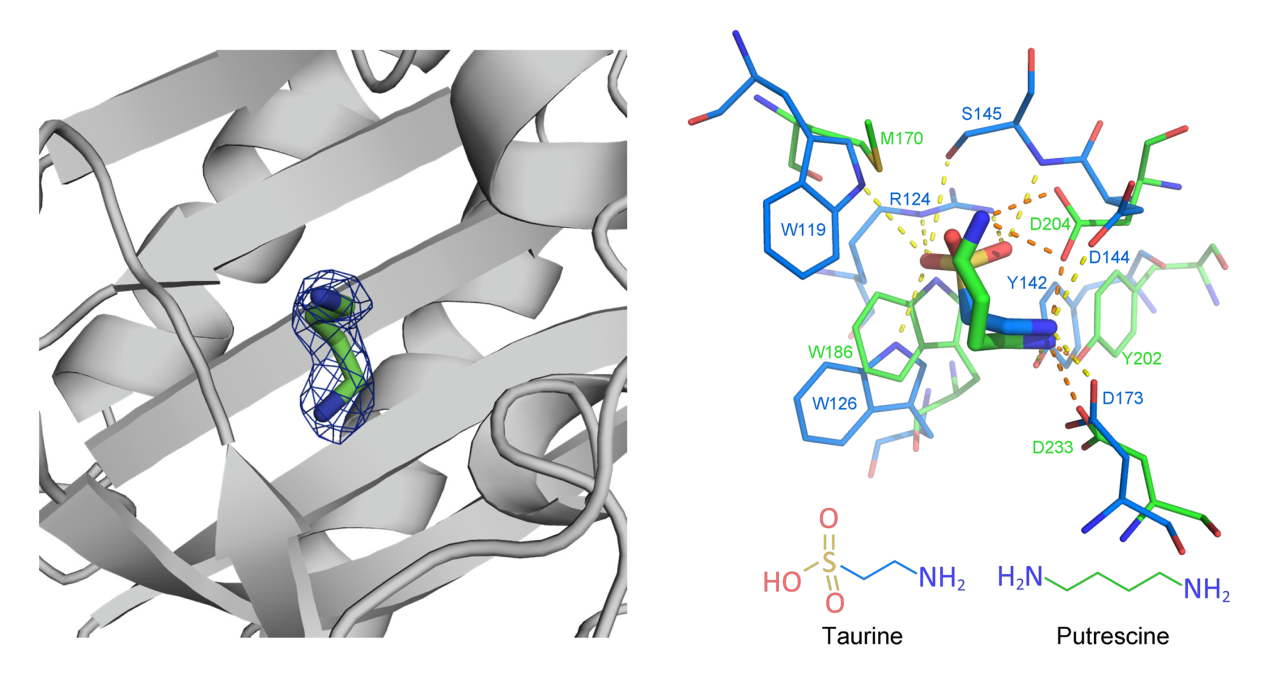
Identification of a plant compound that modulates Pseudomonas aeruginosa quorum sensing
Bacteria communicate with each other via quorum sensing (QS) mechanisms. For many pathogens it has been shown that QS regulates the expression of virulence related genes. It is also known that plants produce and secrete compounds that interfere with pathogen QS signaling, which is considered to be a defense mechanism. However, little is known about the identity of these plant compounds. In Corral-Lugo et al. Science Signaling (2016) 9(409):ra1 (direct link) we identify rosmarinic acid (RA) as a plant compound that interferes with P. aeruginosa PAO1 QS. We show that RA binds tightly to the QS regulator RhlR and in silico docking experiments indicate that RA competes with the cognate C-4-homoserine lactone (C4-HSL) for binding.

In vitro transcription assays demonstrate that RA has a higher capacity to stimulate RhlR-mediated transcription than the cognate C4-HSL.
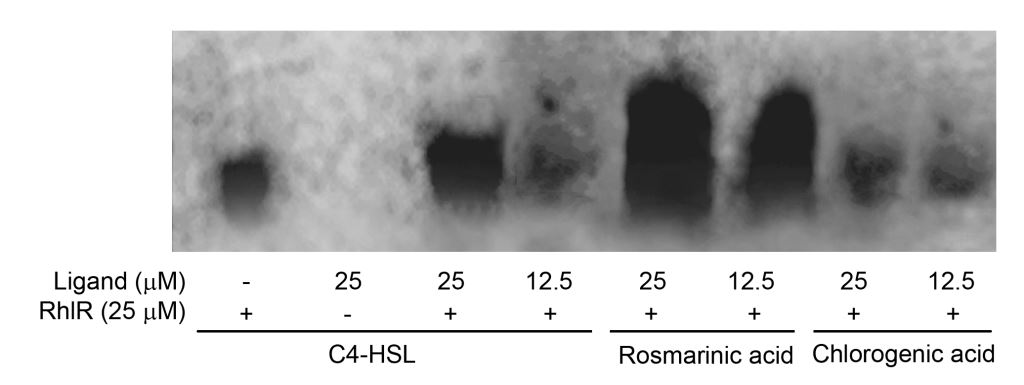
Gene expression studies show that RA enhances the expression from different promoters that were previously shown to be controlled by RhlR. The addition of RA to P. aeruginosa cultures caused a number of typical QS-mediated and virulence-related phenotypes such as increases in pyocyanin and elastase production as well as a stimulation of biofilm formation.
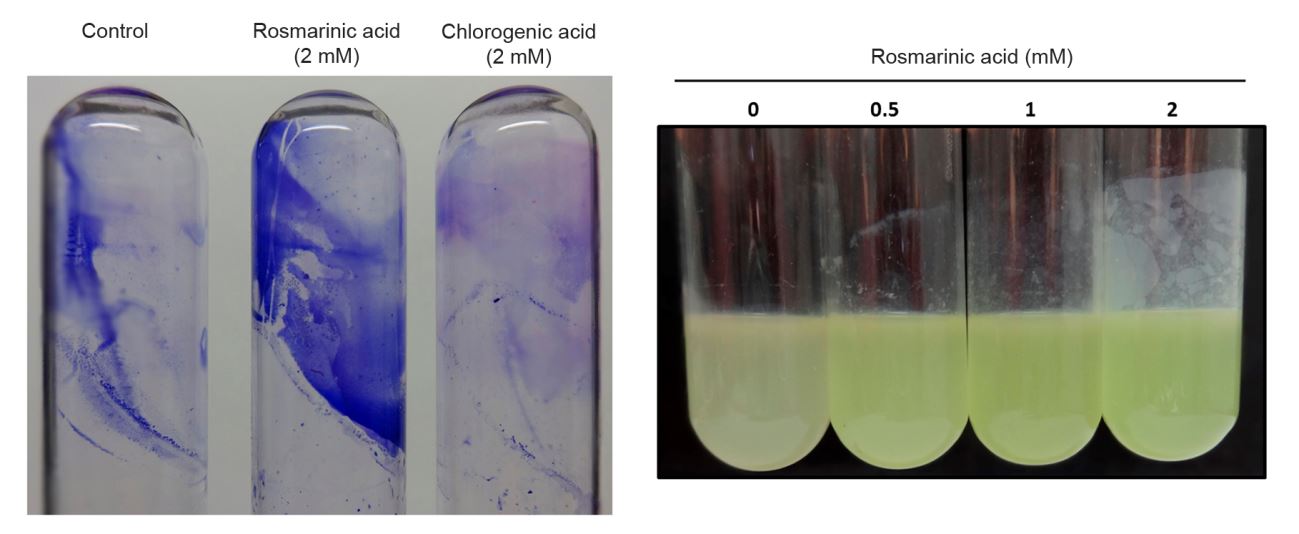
It has been shown previously that P. aeruginosa infection causes RA secretion from plant roots and we hypothesize that the secretion of the QS agonist RA causes premature gene expression. Further work will show to what extent such premature expression modulates the efficiency of plant infection.
The activity of the PA2652 chemoreceptor of Pseudomonas aeruginosa is controlled by chemoattractants and antagonists
The PA2652 chemoreceptor was shown previously to mediate chemotaxis to malate (Alvarez-Ortega & Harwood (2007) Appl Environ Microbiol. 73:7793). We have generated the recombinant ligand binding domain (LBD) of this receptor and have submitted it to high throughput ligand screens using the thermal shift assay (Krell (2015) Mol Microbiol. 96:685). In addition to malate, four other ligands were identified which are shown below.

Although methylsuccinic and citraconic acid bound to the receptor, both compounds did not elicit any chemotactic response. ITC studies revealed the both of these compounds competed in vitro with the three chemoattractants for binding at PA2652-LBD. This competition was also observed in vivo where increasing amounts of both methylsuccinic and citraconic acid, reduced malate chemotaxis (see below). In a control experiment the addition of both antagonists did not reduce chemotaxis to amino acids that is mediated by different chemoreceptors, excluding the possibility that the effect of the antagonists is due to a non-specific interference with bacterial motility. The identification of antagonists thus offers the possibility to specifically interfere and inhibit chemotaxis. This work has been published in Martín-Mora et al. (2018) Sci. Rep. (put the link when available).
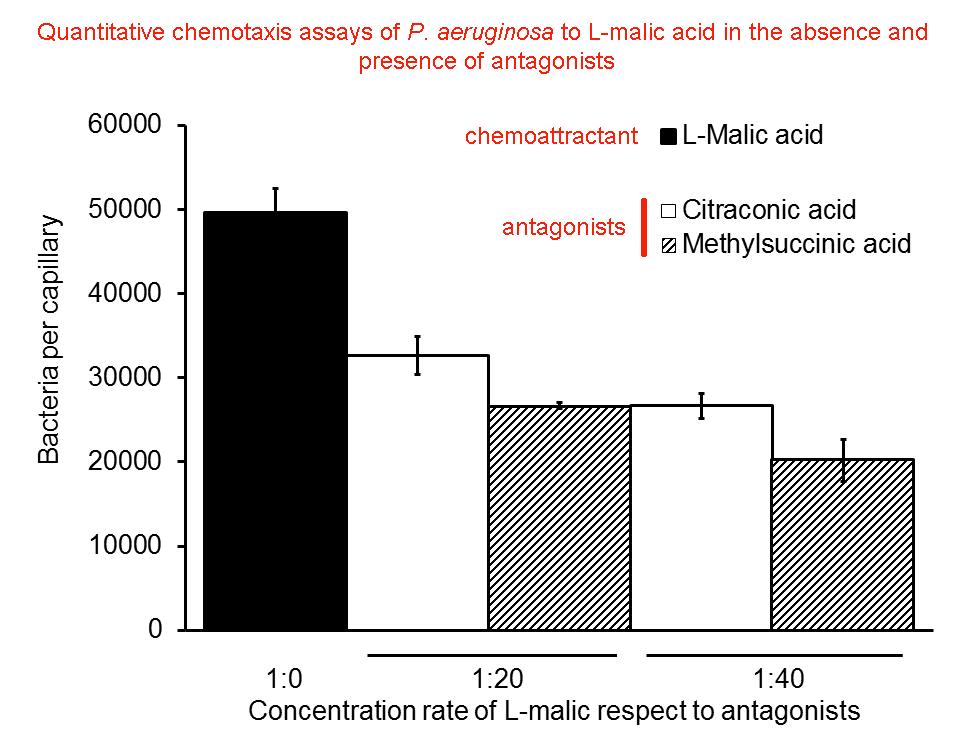
Identification of an α-ketoglutarate specific chemoreceptor in Pseudomonas aeruginosa
Martin-Mora et al. (2016) Front Microbiol. 7:1937. eCollection 2016
Chemotaxis to different Krebs cycle intermediates in P. putida KT2440 is mainly mediated by the McpS chemoreceptor that recognizes most of the intermediates (Lacal et al. J. Biol. Chem. 285:23126-36). Responses to this compound class in P. aeruginosa are based on other chemoreceptors that are characterized by an elevated ligand specificity. In Martín-Mora et al. (2016) (put the link) we identify a chemoreceptor, termed McpK, that recognizes and mediates chemotaxis exclusively to α-ketoglutarate. Previous work by the Harwood laboratory has led to the identification of the malate specific chemoreceptor PA2652 (Alvarez-Ortega and Harwood (2007) Appl Environ Microbiol. 73:7793-5). Chemoreceptors McpK and PA2652 are not paralogous since they employ different ligand binding domains for signal sensing.
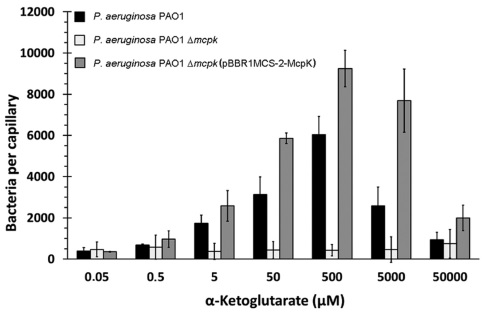
Quantitative capillary chemotaxis assays of wild type, mcpK mutant and complemented mutant strains of P. aeruginosa PAO1 to different α-ketoglutarate concentrations.
Two systems, based on direct and indirect ligand recognition at chemoreceptors, mediate chemotaxis to inorganic phosphate in Pseudomonas aeruginosa
Rico-Jiménez et al. (2016) Scientific Reports 6:28967.
Inorganic phosphate (Pi) is a central signaling molecule that modulates virulence in various pathogens. In Pseudomonas aeruginosa, low Pi concentrations induce transcriptional alterations that increase virulence. P. aeruginosa can move chemotactically in Pi gradients, a process which forcibly alters virulence related gene expression.
Chemotaxis is mediated by the two non-paralogous chemoreceptors CtpH and CtpL. Whereas CtpH mediates taxis to high Pi concentrations, CtpL is responsible for the taxis to low Pi concentrations. Interestingly, both receptors differ in the type of ligand binding domain (LBD) since CtpH has a 4-helix bundle LBD and CtpL a helical bimodular (HBM) LBD.
In Rico Jiménez et al. we show that CtpH and CtpL function is based on different mechanisms. Isothermal titra
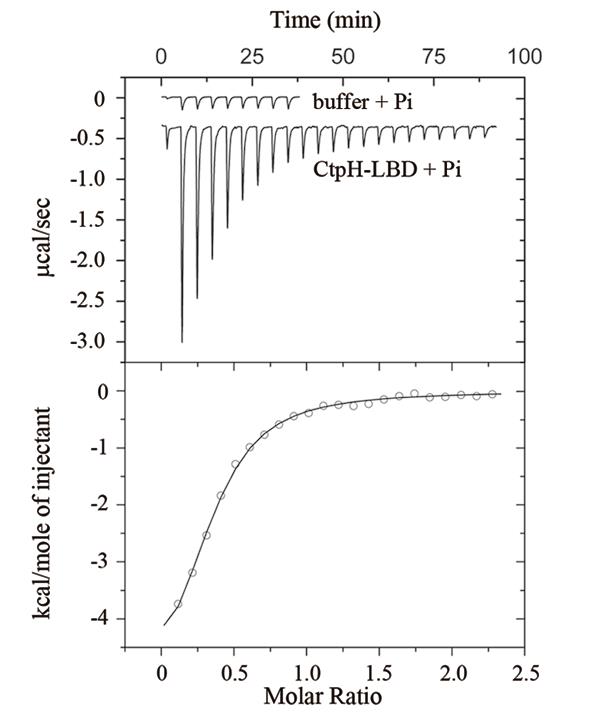
In contrast, CtpL does not recognize Pi directly. Pull-down experiments have led to the identification of the periplasmic binding protein (PBP) PstS as CtpL ligand. ITC studies showed that PstS binds Pi with the very high affinity of 7 nM and Analytical Ultracentrifugation showed a 1 : 1 PstS/CtpL-LBD stoichiometry (below). PstS is a soluble periplasmic protein that as part of the Pi transporter binds to the membrane bound PstA and PstC transporter subunits.
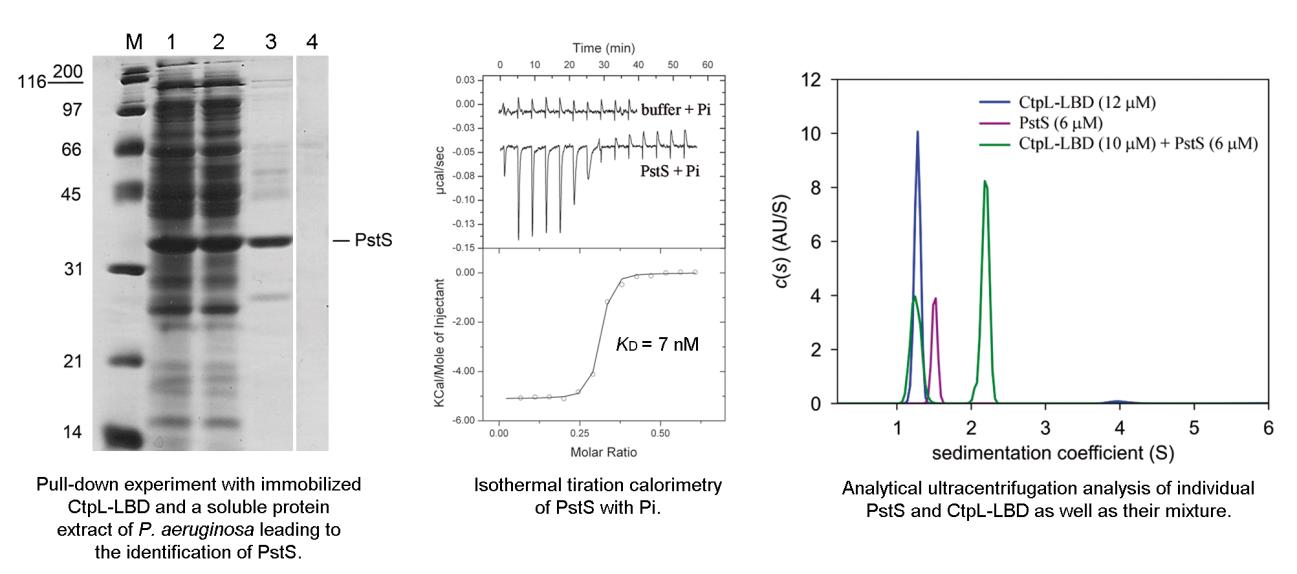
Quantitative capillary chemotaxis assays revealed that the deletion of the pstS and ctpH genes abolished Pi chemotaxis indicating that PstS is the only Pi shuttle for CtpL. Taken together, the model shown below is proposed for Pi chemotaxis and transport. PstS has thus a double function since it delivers Pi to the transporter and the chemotaxis receptor. The expression of pstS is tightly controlled by Pi, which permits a coordination of Pi transport and chemotaxis.
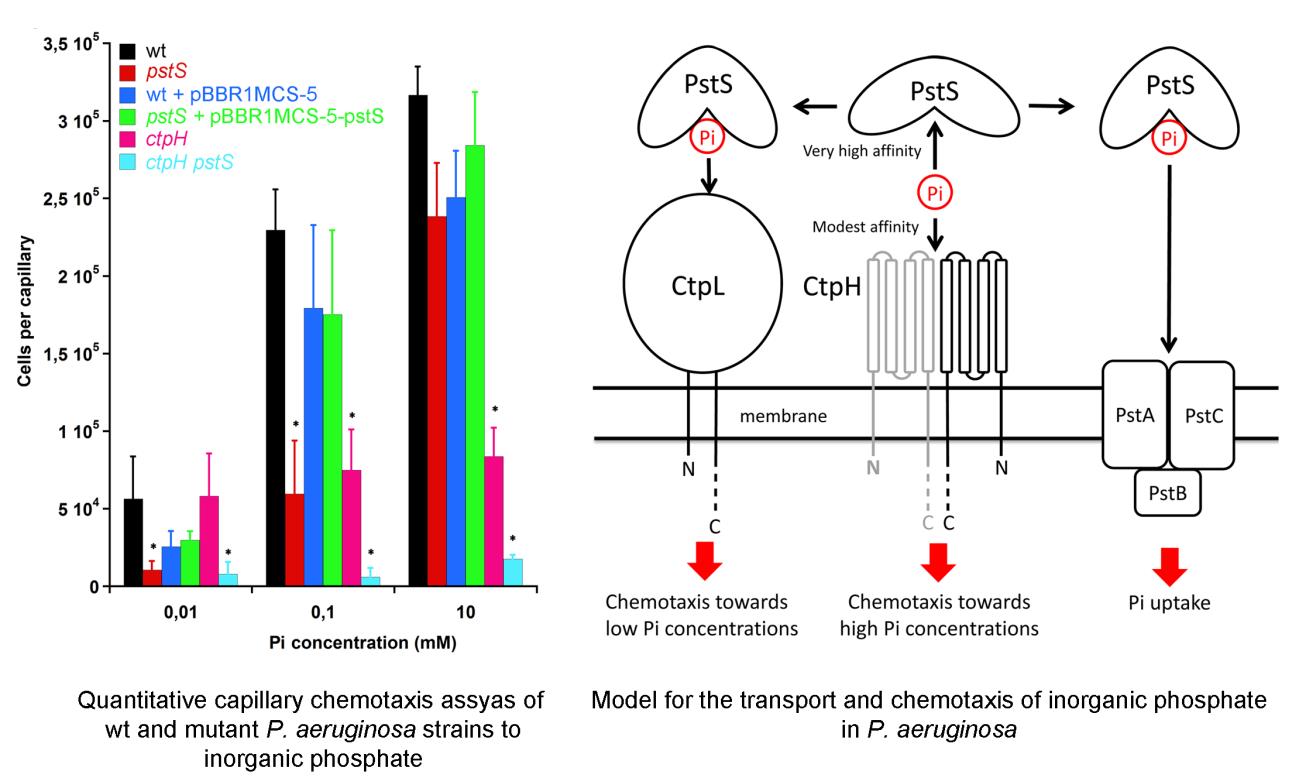
Chemoreceptors that are stimulated by PBPs have been so far reported in enterobacteria for sugars and dipeptides. The identification of a PBP dependent chemoreceptor in a different bacterial order and for a different type of ligand indicates that such systems are widespread in nature.
High-throughput based ligand screening to identify a chemoreceptor for metabolizable purine derivatives
The saprophytic soil bacterium Pseudomonas putida KT2440 has 27 chemoreceptors and a major research lines in our laboratory consists in their functional annotation. One of the un-annotated chemoreceptors is the gene product of PP0320. This receptor contains a periplasmic ligand binding domain of the double PDC type of approximately 260 amino acids. To identify which ligands bind to this receptor, its ligand binding domain was produced recombinantly and then submitted to high-throughput thermal shift assays in the absence and presence of compounds from commercially available ligand collections (Krell, 2015). Increases in the thermal stability (as expressed by the Tm value) strongly indicate ligand binding.

This figure shows Tm changes in the presence of 95 different screened compounds. Four compounds, adenine, guanine, xanthine and uric acid, caused significant protein stabilization or destabilization. Interestingly, these four compounds are differently substituted purine derivatives; hence the hypothesis that this receptor may respond to purines.
Isothermaland to test binding of other related compounds. The results from this series of experiments are shown below titration calorimetry experiments were conducted to verify the hits obtained by the thermal shift assays.

This receptor domain was found to bind purine, a compound that does not exist in nature, as well as five different purine derivatives that form part of the purine degradation pathway, which permits growth of the bacterium on these compounds as sole nitrogen source. Binding was highly selective, since no interaction was observed for non-metabolizable purine derivatives (caffeine, theophylline and theobromine), pyrimidine bases, nucleotides or nucleosides. We conclude that this receptor, which we have termed McpH, binds exclusively metabolizable purine derivatives.
Shown below are qualitative capillary chemotaxis assays of the wild type strain, the mcpH mutant as well as the complemented mutant.

The wt strain showed significant taxis towards the McpH ligands identified. However, deletion of the mcpH gene abolished chemotaxis, which was re-established upon complementation.
This is the first report of chemotaxis towards purine derivatives, which also shows that this type of taxis is mediated by a dedicated purine receptor. This study also illustrates the usefulness of the thermal shift based approach, which can not only be used to functionally annotate chemoreceptors, but also other bacterial sensor proteins.
Mechanism for the specific targeting of a CheR methyltransferase to a chemoreceptor
Studies with E. coli that contain a single CheR and CheB show that, apart from binding at the methylation site, some chemoreceptors recognize CheR and CheB at additional high-affinity sites at C-terminal pentapeptides in the chemoreceptor. The opportunistic human pathogen Pseudomonas aeruginosa PAO1 has 4 CheR paralogues and several receptors with C-terminal extensions. As published in García-Fontana (2014) Science Signaling 7, ra34 (full text: click here, pdf version: click here) we found that exclusively CheR2 bound to the McpB chemoreceptor, which contains the GWEEF pentapeptide at its C-terminus.
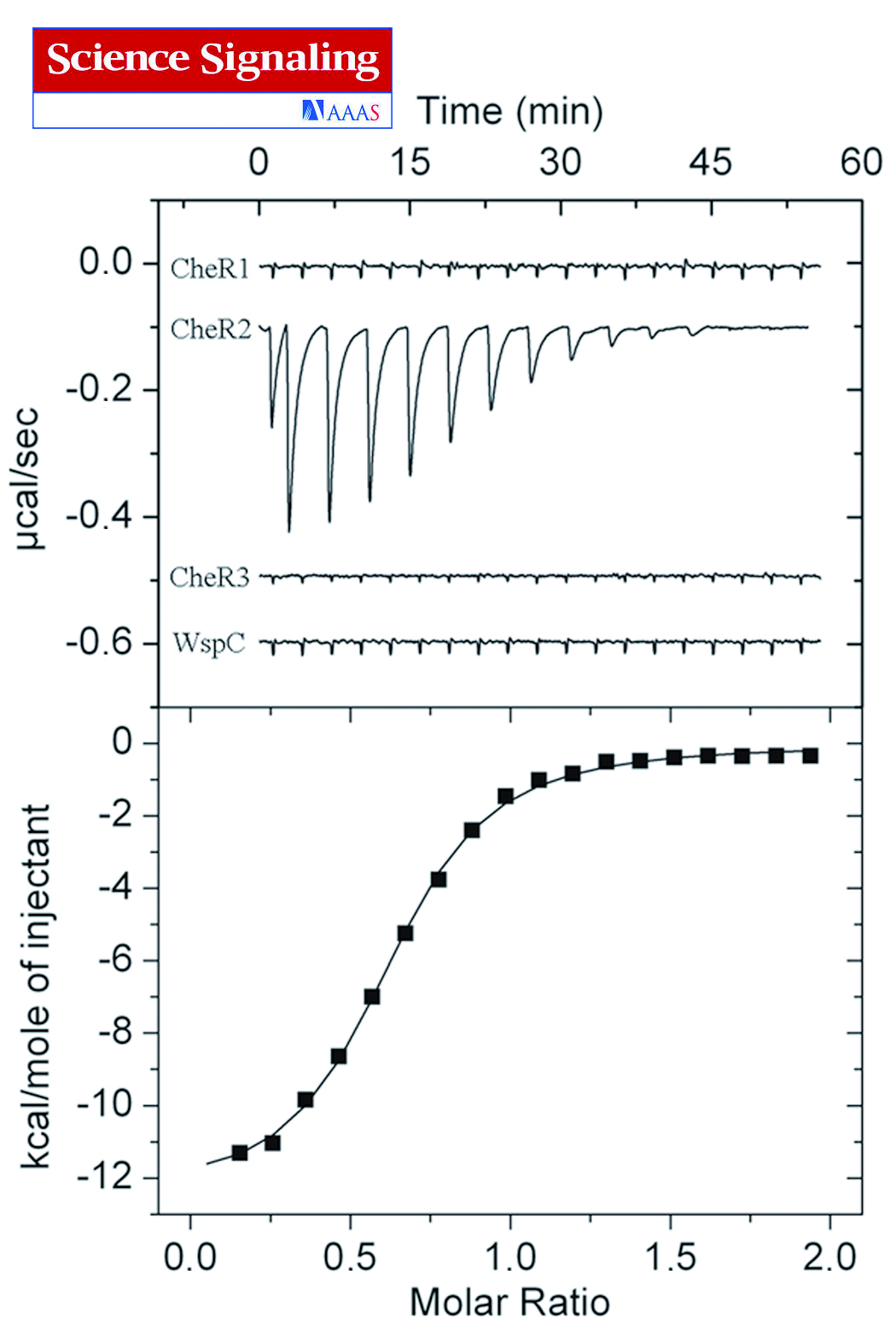
We show CheR2 was the only paralogue that methylated McpB, and deletion of the pentapeptide abolished both the CheR2-McpB interaction and the methylation of McpB. The cheR2 and mcpB genes are vicinal in the P. aeruginosa genome and form part of the gene cluster that encodes the Che2 chemosensory pathway. We conclude that the CheR-pentapeptide interaction enabled the specific targeting of one CheR methyltransferase to one chemoreceptor. We also found that bacterial CheR proteins form two distinct protein families when clustered according to sequence, those that bind pentapeptide-containing chemoreceptors and those that do not, distinguished by an insertion of three amino acids in the β-subdomain of CheR. Deletion of this insertion in CheR2 prevented its interaction with and methylation of McpB. Because many bacteria contain pentapeptide-containing chemoreceptors and several signaling protein paralogues, we predict that the mechanism described may contribute to the specific assembly of signaling proteins to form distinct, parallel pathways that mediate different responses.
Definition of a novel bacterial sensor domain
We have published recently the 3D structure of the sensor domain of the McpS chemoreceptor (Pineda et al., 2012) that mediates chemotaxis to various organic acids (Lacal et al., 2010). The McpS sensor domain as shown in this figure corresponds to a novel small molecule sensor domain that is composed of two modules to which each signal molecules bind. In Ortega and Krell (2013) we now report the domain signature of the family of McpS-like sensor domain that we term Helical Bimodular Domain (HBM). This domain was found in Bacteria and Archea and forms part of chemoreceptors and histidine kinases. We showed that the most conserved amino acid are located in close proximity of the two ligand binding sites, indicating that family members may recognize similar ligands. Using this profile we have identified so far 1200 members. The domain profile will be sent to relevant databases like Pfam or Prosite.
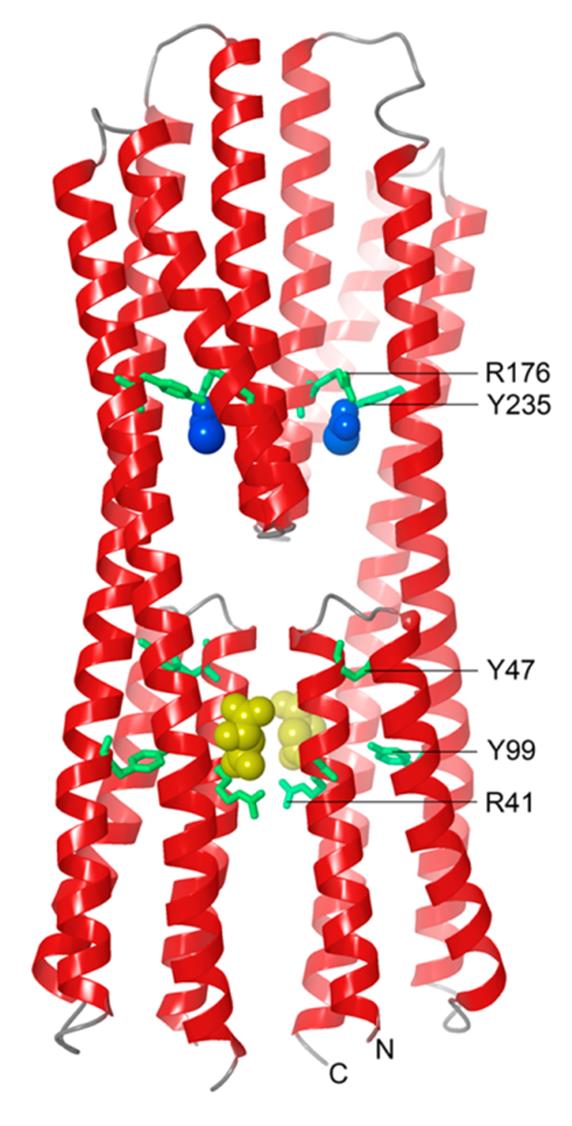
Figure legend: Three dimensional structure of the HBM domain. Shown is the 3D structure of the sensor domain of the McpS chemoreceptor. Bound acetate and malate are shown in space-fill mode in blue and yellow, respectively. Most conserved amino acids in a sequence alignment of HBM family members are labelled and shown in ball-and-stick mode.
Multiple signals modulate the activity of the complex sensor kinase TodS
Many sensor kinases have a complex domain arrangement of which the physiological relevance is poorly understood. It was hypothesized that this complexity may permit to perceive different types of stimuli that result in a fine-tuning of the transcriptional response, but experimental proof of this hypothesis is scarce. The 7-domain TodS sensor kinase of Pseudomonas putida DOT-T1E is composed of almost 1000 amino acids (see Figure). It transphosphorylates the TodT response regulator that in turn controls the expression of a toluene degradation pathway
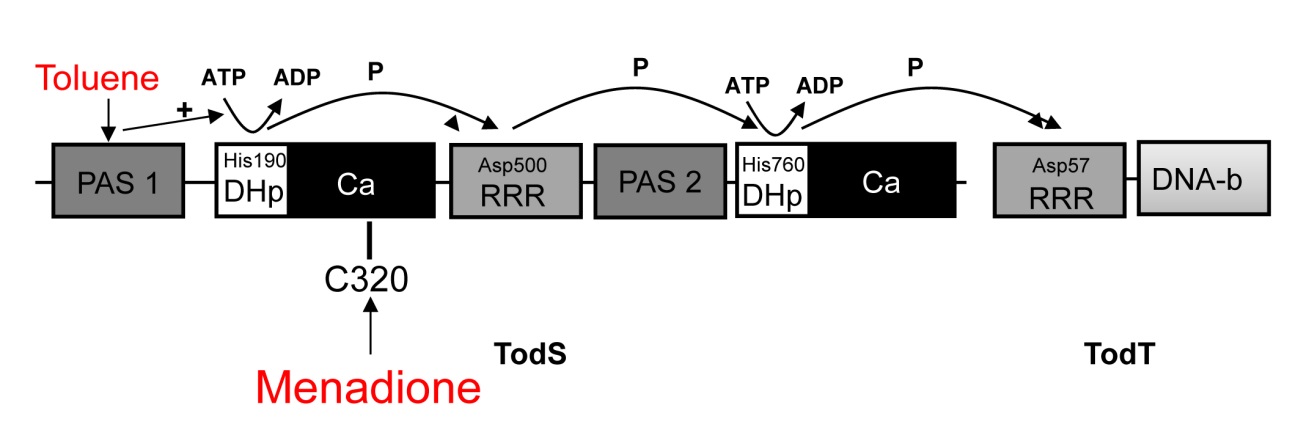
We have shown previously that toluene and other monoaromatic compounds modulate TodS autokinase activity by binding to the PAS1 sensor domain (Lacal et al. (2006) PNAS 103:8191). We have now shown that the oxidative stress agent menadione in addition to toluene modulates TodS activity in a specific manner (Silva-Jiménez et al. (2014) Microb. Biotechnol.). We also show that menadione action involves the modification of cysteine residue 320. This residue is the only conserved cysteine in an alignment of protein family members. The activity of TodS is thus controlled by the presence of monoaromatic compounds and the cellular redox potential, providing support to the above hypothesis.
Multiple effects of prebiotic oligosaccharides on Pseudomonas aeruginosa
We report a study on the effects of inulin and its hydrolysed derivative fructooligosaccharide (FOS) on different features of P. aeruginosa (Daddaoua et al., 2014). We show that FOS reduces bacterial growth, biofilm formation and motility. In co-cultures with eukaryotic cells FOS reduced the secretion of several inflammatory cytokines. Further results are shown that suggest that the FOS mediated effects may be related to a decreased activation of the NF-κB pathway. Our results suggest that FOS may be useful components of antibacterial and anti-inflammatory drug cocktails.
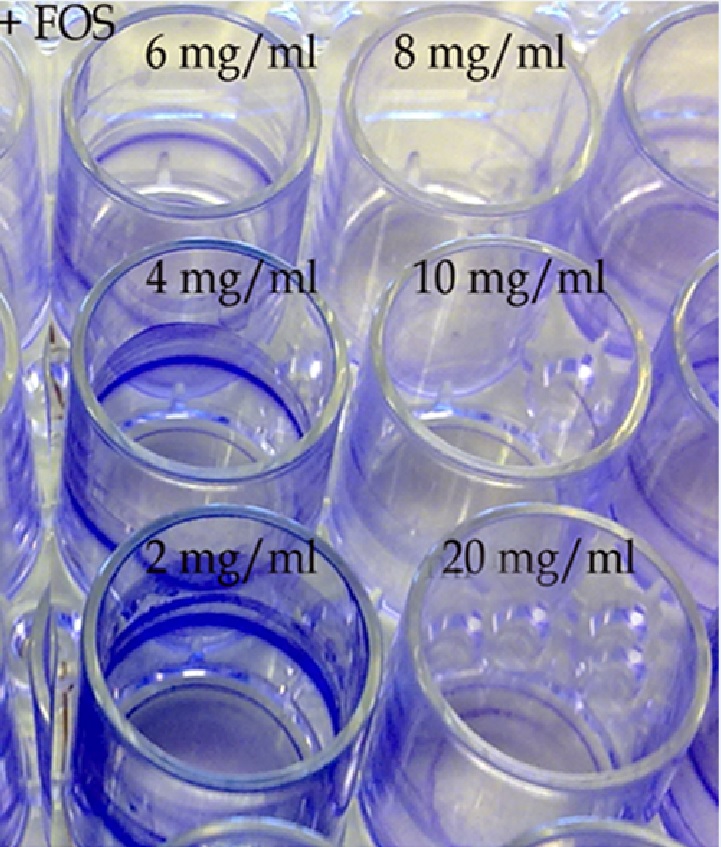
Figure legend: Reduction of biofilm formation in the presence of different FOS concentrations.
Correlation between signal input and output in chemoreceptors based signaling
A common feature of signal transduction systems is the existence of mechanisms for signal detection (input) and the generation of the regulatory response (output). A central question consists in establishing whether the magnitude of input, or affinity of the signal for its sensor protein, determines the magnitude of regulatory output. Previous studies in our laboratory of one- and two-component systems have shown that this is not necessarily the case (Guazzaroni et al. JBC (2007) ; Busch et al. PNAS (2007)).
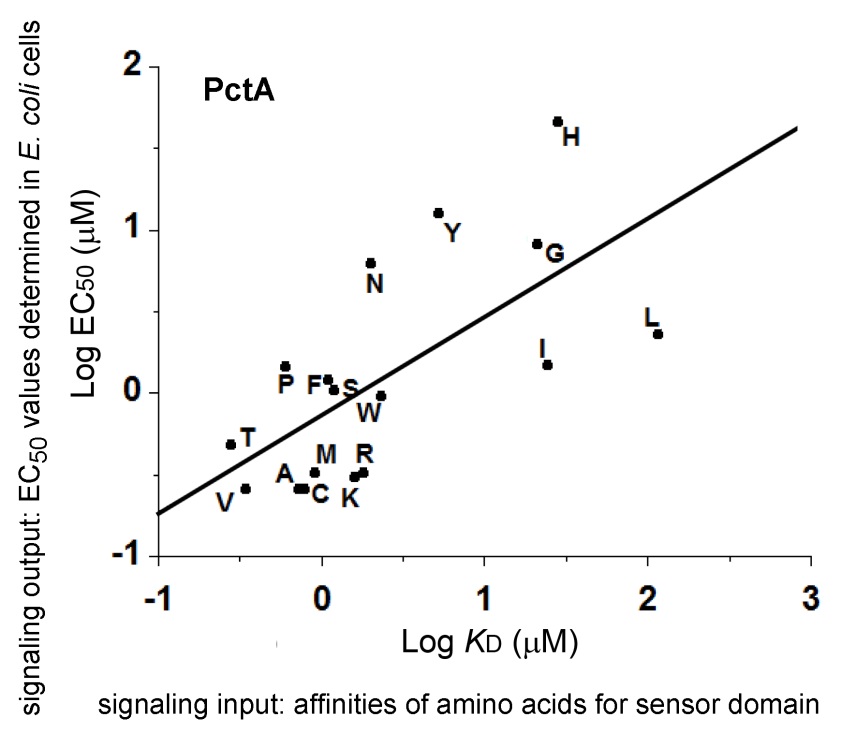
We have now assessed signal input and output relationships for chemoreceptor based signaling cascades using the PctA and PctB amino acid chemoreceptors of Pseudomonas aeruginosa as models (Reyes-Darias et al. Mol. Microbiol. (2015)). To calculate output, receptor chimeras were constructed fusing the PctA and PctB sensor domain with the signaling domain of the Tar receptor from E. coli. These chimeras were introduced into a chemoreceptor free E. coli mutant and the EC50 values of the response towards different amino acids determined with the FRET assay. We were able to show that for both receptors the magnitude of EC50 values (output) correlates with the affinity of the amino acids for the recombinant ligand binding domains (input) as determined previously (Rico-Jiménez et al. Mol. Microbiol. (2013), see Figure). We are thus able to conclude that, for the receptors studied, the signal affinity determines the magnitude of regulatory output.
Pseudomonads with different lifestyles show specific chemotaxis to Gamma-aminobutyrate (GABA)
After the identification of PctC as the receptor responsible for GABA chemotaxis in P. aeruginosa PAO1 (Rico-Jiménez et al. (2013) Mol. Microbiol.) we report in Reyes Darias et al. (2015) Mol. Microbiol. the identification of the McpG chemoreceptor that binds and mediates chemotaxis exclusively to GABA.
The microcalorimetric titration of the recombinant ligand binding domain of McpG (below) revealed a dissociation constant for GABA of 175 nM, which is amongst the highest ever measured affinities of a signal molecule to a bacterial sensor protein.
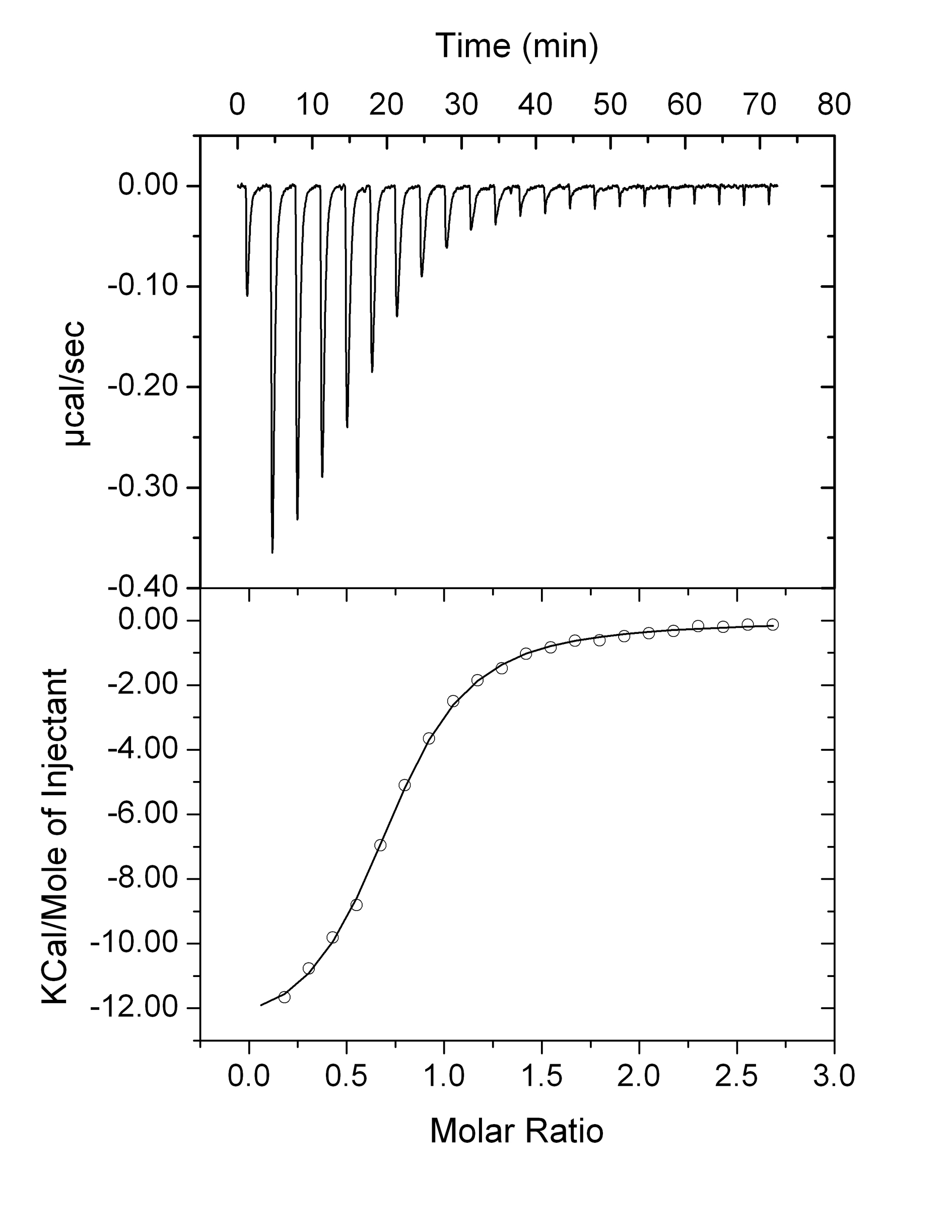
We have detected GABA in exudates of tomato roots and have shown that the mutation of the mcpG gene reduces the magnitude of root colonization following chemotaxis through soft agar (below).

